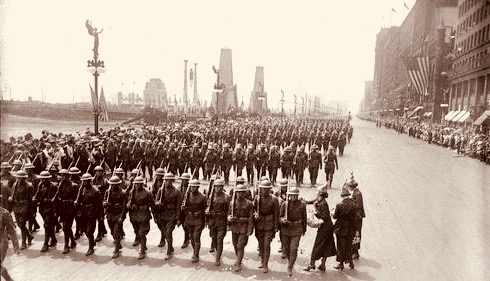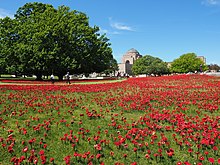World War I Centenary

The homecoming of the 33rd Division as they march down Michigan Avenue in the spring of 1919 after returning from serving in World War I. One thousand flower girls were positioned along the line of marchers to provide a “posy path” of flowers for the veterans. (Chicago Tribune historical photo)
Remembering World War I
100 years ago the First World War ended, and a new world began. The example and experience of those who lived through it shaped the world we live in today. On the centenary of the Armistice, it is right that we come together to give thanks to those who paid the ultimate sacrifice and those who returned home to help shape the world we live in today.
World War I Centenary
The First World War Centenary is the centenary of the First World War, which started on 28 July 2014 with commemorations of the outbreak of the war and will continue until 11 November 2018.

OLYMPUS DIGITAL CAMERA
Part of the 62,000 Poppies Display which was exhibited at the Australian War Memorial from 5 October to 11 November 2018. Each poppy represents an Australian killed in World War I.
In Australia, the occasion is known as the Anzac Centenary. Committees planning the event include the National Commission on the Commemoration of the Anzac Centenary and the Anzac Centenary Advisory Board. The government has budgeted $83.5M for a seven-year programme which will include commemorative events in Australia and overseas; educational activities and resources; and refurbishments of galleries and war graves. The Brisbane City Council has spent $13.4 million to refurbish the Shrine of Remembrance, Brisbane located in ANZAC Square and $1 million revitalising 31 suburban war memorials. Many commemorative events were organised by governments and other organisations. During the centenary of the First World War, Australia is said to have spent more than any other country put together to celebrate the Anzacs.
The centenary of World War I is to be marked by a program of exhibition, lectures and academic research focusing on the theme of Belgian involvement in the conflict and the occupation. The Royal Museum of the Armed Forces and Military History in Brussels hosted an exhibition titled “Expo 14–18: It’s Our History” from 2014 to 2015.
The city of Sarajevo, where the assassination of Archduke Franz Ferdinand took place, organized a commemoration in the period 21–28 June 2014. The event was named “Sarajevo, heart of Europe.”
Filmmaker Emir Kusturica announced an initiative to hold a ceremony on 28 June 2014, in which a re-trial of Gavrilo Princip will be started. The motivation behind the initiative was that Austria-Hungary never ratified the annexation of Bosnia and Herzegovina, and that a verdict of high treason therefore should be considered illegal. “It was a political murder, but definitely not high treason. If Princip was convicted of murder, it wouldn’t have been possible to sentence him to lifetime imprisonment”, Kusturica commented. Further, he will exhibit letters written by Oskar Potiorek, and argues that they prove that a war was planned long before the Sarajevo Assassination.
The centenary of the First World War was commemorated on 3 August, the date of the German declaration of war on France. A wreath-laying ceremony was held at the National War Memorial, before continuing at the Canadian War Museum. During the ceremony, Prime Minister Stephen Harper announced the permanent extension of the Ceremonial Guard’s sentry hours, from Vimy Ridge Day to Remembrance Day.
Other tributes were also held in Halifax, where lights will shut off at major landmarks, and an ecumenical service at the Basilica of St. John the Baptist in St. John’s. The event was also commemorated in Toronto in an event organized by the tourism office for Flanders, where a group of men in newsboy costumes distributed fictitious historical newspaper describing the major events of the war. The centenary of the war was also the theme of the 93rd annual Warrior’s Day Parade, held on 10 August at Toronto’s Canadian National Exhibition.
The Czech Radio is running several accounts on the social networks where they are remembering all the events from the World War I day-by-day. That is accompanied by a special website with an archive of radio programmes with stories from World War I.
The Czech Republic was part of Austria–Hungary.
The cultural network “Golden Days” is planning a commemoration in September 2014, “1914, the Gateway to Modern Europe.”
Denmark remained neutral during World War I and did not take part in the warfare. The biggest event from a Danish perspective is the reunification with Northern Schleswig (Sønderjylland) in 1920. After the Second War of Schleswig in 1864, Denmark was forced to cede Schleswig and Holstein to Prussia. In 1918, the Versailles powers offered to return the region of Schleswig-Holstein to Denmark. After the Schleswig Plebiscites Northern Schleswig (Sønderjylland) was recovered by Denmark in 1920. The reunion day (Genforeningsdag) is celebrated every 15 June on Valdemarsdag.
In France, the government will carry out a policy of national remembrance. An early start was made in 2011 with the opening of Le Musee de la Grande Guerre in Meaux on Armistice Day. France set up an official board for the commemoration of the centenary under the name of Mission du Centenaire.
The centenary of the First World War will be marked in Ireland. A cross of sacrifice was erected in Glasnevin in Dublin, which also included a joint Irish-British commemoration ceremony. A season of First World War programmes will also be broadcast on RTÉ.

